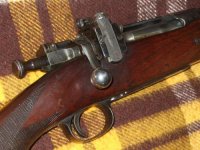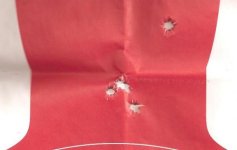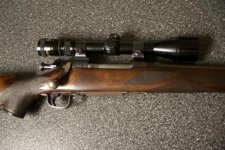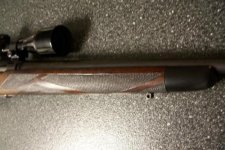M
Montana Pete
Guest
I posted a message here a while back entitled something like "Classic 03 Springfield." There were some photos.
Yesterday I got out to the range with 20 fresh rounds for the rifle. This is a sporterized NRA Springfield with a star-guage barrel.
The only sights I had were the original Lyman Model 48 aperture sight, with a ramp and front blade, with a sight hood.
I only had 20 rds, and wasted 10 at 50 yds, because the gun has not been fired in 25 years, and I wanted to be sure I was on the paper.
One of the two strings at 100 yds is enclosed as a photo. I used the big silhouette target because small targets tend to look pretty tiny at 100 yds, and I wanted an adequate aim point.
The rifle put four in 0.825 inches, with one flyer.
For what it is worth, ammo was as follows: New Hornady brass, Nosler 168 gr. HPBT bullets, 42.5 gr. of IMR 3031, and CCI "200" primers.
I also include a photo of the sight. The photo shows a hunting aperture, but I did put a finer target aperture into the sight before the testing.
It appears the old Springfield still shoots. Since I am nearly 70, I was happy that I can still use the iron sights.
Yesterday I got out to the range with 20 fresh rounds for the rifle. This is a sporterized NRA Springfield with a star-guage barrel.
The only sights I had were the original Lyman Model 48 aperture sight, with a ramp and front blade, with a sight hood.
I only had 20 rds, and wasted 10 at 50 yds, because the gun has not been fired in 25 years, and I wanted to be sure I was on the paper.
One of the two strings at 100 yds is enclosed as a photo. I used the big silhouette target because small targets tend to look pretty tiny at 100 yds, and I wanted an adequate aim point.
The rifle put four in 0.825 inches, with one flyer.
For what it is worth, ammo was as follows: New Hornady brass, Nosler 168 gr. HPBT bullets, 42.5 gr. of IMR 3031, and CCI "200" primers.
I also include a photo of the sight. The photo shows a hunting aperture, but I did put a finer target aperture into the sight before the testing.
It appears the old Springfield still shoots. Since I am nearly 70, I was happy that I can still use the iron sights.





